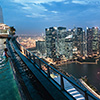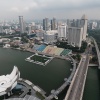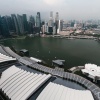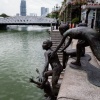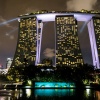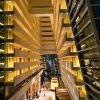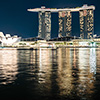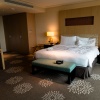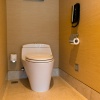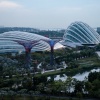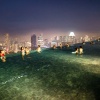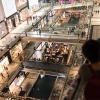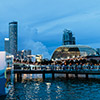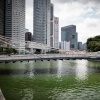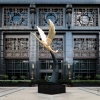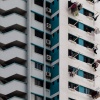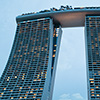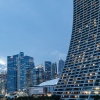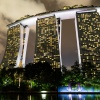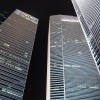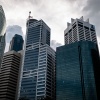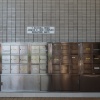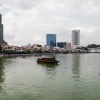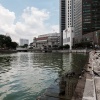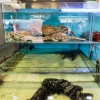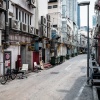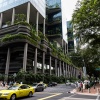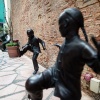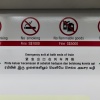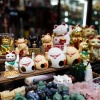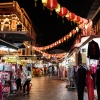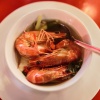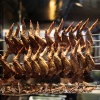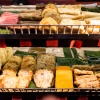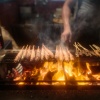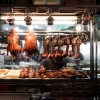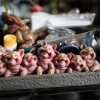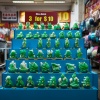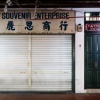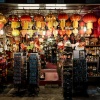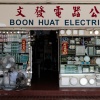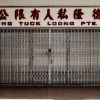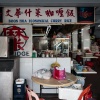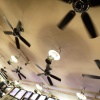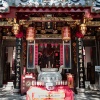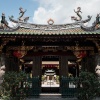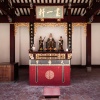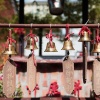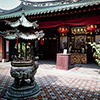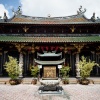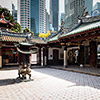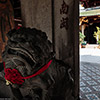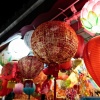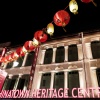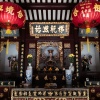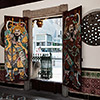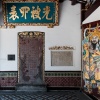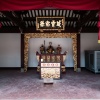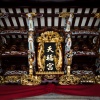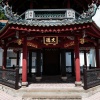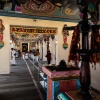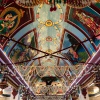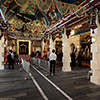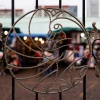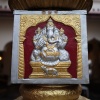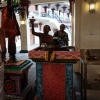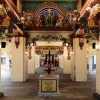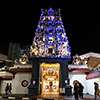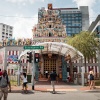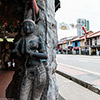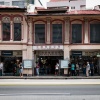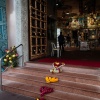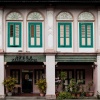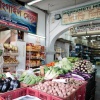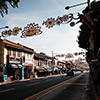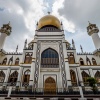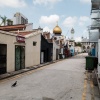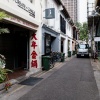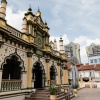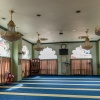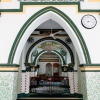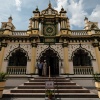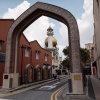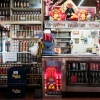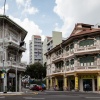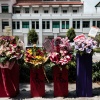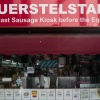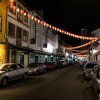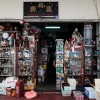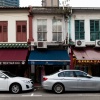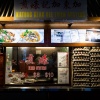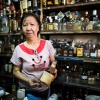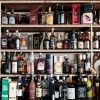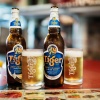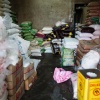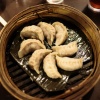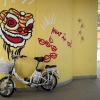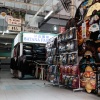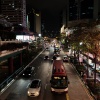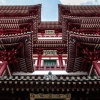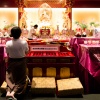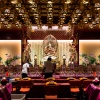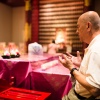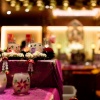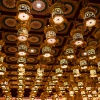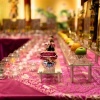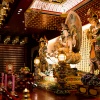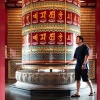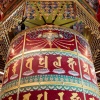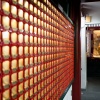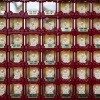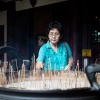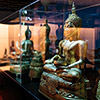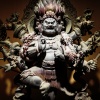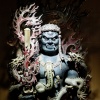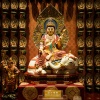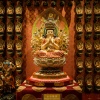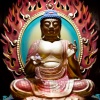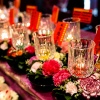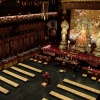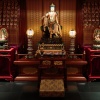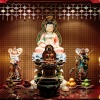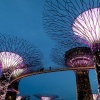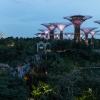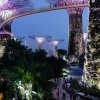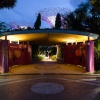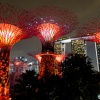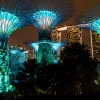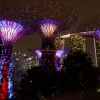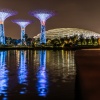Singapore – Interface of Southeast Asia
Singapore sits at the seam of Southeast Asian mainland and the island world of Indonesia. With 5.5 million people living on ~700km² it is not only one of the smallest but also most densely populated city states in the world. Since ever the metropolis was a point of commerce, known to Arabs, Indians, Chinese and of course Malayans. That ethnic mix as well as its compact development coin a cityscape that boasts of historic-religious important Hindu and Buddha temples as well as with fully automated metros, an almost clinically clean appearance and a luxury glass steel architecture that culminates in Marina Bay Sands and its Infinity Pool.
Right beside me at the bar are four Asians being absolutely indiscernible from lady boys, even at the second and third glance. Their search for someone buying them drinks comes to nothing, hence mauling their smartphones they disappear in the parallel world of Facebook, WhatsApp & Co. Thinking “Hands off!” I wash down the view of those hybrid (fe)male visages with a cocktail made from Hakushu whisky, ginger and orange juice. What a drink…!
The barkeeper is really good and mixes self-creations being influenced by Asian herbs, such as Thai basil infused vodka, Triple Sec and citrus juices. The girls sitting opposite – yes, this time real girls – have a good time watching my culinary indulgence. Quickly we notice that we’re all from Germany. Due to the general price level up here they have a beer only, that it’s still much more expensive than back home. Alcohol in Singapore isn’t cheap.
Further in the background sits a well 60 year old baldhead Indian money back. Lounging in the armchair his presence is characterised by the attempts of getting MUCH closer to his 30 years younger, European (paid?) female company. Meanwhile the bar is buzzing. Measured by tab amounts noticed the goal of reaching a revenue of 1 billion US$ per year shouldn’t be a problem for Marina Bay Sands, as also staying overnight costs the little fortune of at least 300 Euros, probably more. Rooms facing the Gardens by the Bay side have a grain of salt though, as the highway running in front of the hotel will show you the influence of car traffic on human sleep.
The Infinity Pool on top of the surfboard shaped Marina Bay Sands roof is just awesome. After being open to the public, the pool itself is only accessible for hotel guests for a couple of years now. Floating around with a cocktail in your hands while watching the metropolis’ illuminated glass and steel facades from a 191 metres high is definitely very impressive. Still sitting at the bar I give the German girls from Hunsrück mountains my key card to make them not leaving Singapore without having seen this pool perspective of the financial district.
Up here you can float in the water having a great cocktail, but you can also clearly notice Singapore’s biggest problem, that is air pollution, a thick wafting brownish layer emerging from traffic and hundreds of container vessels keeping their engine running as they wait to enter the harbour. All too often their smog lets the moment of the setting sun appear surreally leaden grey.
In the evening the Infinity Pool of Marina Bay Sands advances to a vanity fair as it becomes the worldwide number one stage for taking selfies. I surrender, leave the pool to all self-exposers and go down to my palace-like apartment. The mix of jetlag and the highway in front of the building (sad but true, a several hundreds of Euros costing hotel room isn’t soundproof) doesn’t let me sleep restfully. The next day starts at 4 o’clock in the morning and leads me (later) to Chinatown, also hotel-wise.
Chinatown as well as the Arabic quarter and Little India are the remnants of former enclaves harbouring foreign ethnicities and cultures, while today’s Singapore is a mix of Malayans, Chinese and Indians. Except Little India and a few other local exceptions, Chinatown became quite a tourist trap though, unfortunately.
My hotel is right opposite of a Hindu temple where all around the clock people celebrate a mass. Being accompanied by a hypnotic tape-recorded Sitar worshippers circumambulate the shrine building while someone else plays an up and down swelling Shehnai 24 hours a day. Man, that’s more Indian than India itself, also because of the phlegmatically looking Hindu guy banging a bell every 20 seconds anew; dong, dong, dong…
The whole Hindu scenery, that is even more Indian than India itself, pretty much reminds me of my trip through North India, in particular my visit of the crazy Rat Temple Karni Mata in Deshnok.
Chinatown is full of junk, sometimes even quite expensive junk. People being able to distinct between quality and rubbish may find their commercial happiness though. For example I fell for the pitchmen of Silk of the Orient‘s hook. While being in Singapore I could take control about everything, how my future suit should be tailored like and what every detail should look like. I had to correct many things…, though the whole tailoring process worked out. Now here is the hook, as I mistakenly believed that they could mail me a second suit having same cut, same style but a different fabric. All those little problems and faults I found before the first suit got finalised were back. Their promise “mail order is our excellence!” is nothing but an empty phrase.
Logically you can find the Chinatown Food Street in Chinatown. The food stalls there are reminiscences to former Dai Pai Dongs, the typical mobile Chinese snack shacks on wheels, that got banned from the streets of Singapore though as they are “not clean enough”. Nowadays they, as well as many other places on notorious Chinatown Food Street, deliver semi-well cuisine, for example they use normal industry-made spaghetti instead of original Chinese noodles. In general all dishes under 12SG$ are rather chemical-industrial instant stuff that only need hot water to become added… An exception is the Noodle Man, who offers his quality hand-made cooking arts at very good prices.
To people liking upscale places and haute cuisine I recommend a visit of Ding Dong. What sounds a bit like a ring tone is one of the best restaurants around in the Chinatown area. Beside very own cocktail creations they deliver a fresh Asian fusion kitchen that doesn’t hesitate to surprise as an affordable well-tasting experiment at highest level. Eating out as well alcohol are rather expensive things in Singapore, also because whenever service is involved, you get charged an additional 10% service fee.
In the end a normal meal piles up to cost 50-75 Euro pax. Same thing can happen to a bar night and having had only a couple of beers. Ding Dong restaurant neighbours with Club Street where you can find plenty of other places that are literally packed, particularly on Fridays and Saturdays. Without reservation and as a solo traveller things will become difficult.
Not far from Chinatown and its food street two major religious places are located, that is the huge Buddha Tooth Relic Temple complex and its museum as well as the Taoist Yu Huang Gong Temple in Telok Ayer Street. Latter one stood the ravages of time and shines in brightest colours again after being reopened to the public in December 2014 and major reconstruction works. The local monks restored the temple from own funds and it couldn’t be more contrasty as it’s an oasis of peace amidst the bustle of the Southeast-Asian metropolis.
Also it presents terrific optical opposites when the usual western glass-steel facade porn meets classic religious-historical Chinese architecture. The huge Buddha Tooth Relic Temple is much younger and got built in 2002. Nevertheless also this place is a stronghold of tranquillity and reflection. Its upper stories accommodate a museum having countless rooms exhibiting countless Buddha statues. Some of them are hundreds of years old.
Those Asian-Buddhist as well as Indian-Hindu remnants are authentic, highly interesting and have their own vibe, though they are not able to cover the commercial basic nature of the Southeast Asian city state. Entirely westernised, you even might think Americanised – e.g. Changi airport serves as base to US troops for operations in Southeast Asia – huge malls (the temples of surrogate religion consumption) and smartphones (as mirror of social vanities) play a much more important role than upright Asian values. Fortunately that transformation process didn’t influence local food as much as elsewhere, like for example in Pacific Ocean, where “protecting power” USA abused their local presence to maximise market power by cutting out traditional food through burger and fast food made in USA.
The manmade artificial side of Singapore culminates in the Gardens by the Bay, a free of charge botanical garden offering a light show every evening anew. Don’t get me strong, the garden, having the backdrop of an army of container ships waiting at the horizon, is class and accommodates virtually all endemic plant species, but the light show is a little pompous; in particular the background music that is literally able to deliver you dozens of infantile ear worms that journey through your head the whole night. Well, tourists from all over the world indulge that, hence they brandish their smartphones whose sum of displays shines even brighter than the LEDs of the artificial tree giants.
Due to all vanities happening around Marina Bay Sands, due to so many young people being nothing but daughter or son, I go back to more authentic climes, that is Little India, where Masjid Abdul Gafoor, a very interesting mosque peeps out of the mass of obligate Hindu shrines. If you stick to the dress code then it’s no problem to have a look at the mosque’s premises, something that’s impossible at Masjid Sultan on Arab Street, where authorities mean to dissociate themselves religiously as well as culturally by using non-existing conservation works as excuse to reject visitors. That policy is matching the basic nature of Arabic quarter though as it’s got to do with Arabia as much as kangaroos do with polar bears.
Little India is terrifically Indian with all those quirky details and peculiarities known from the subcontinent. An old lady sticks out though, that is more than 60 years old Hui and her Shop of Thousand Bottles, a place that rather reminds of a rubbish dump with opening hours if you stand in front of it. The striking diversity of unopened liquors collected from all over the world is a jaw-dropper par excellence. Proudly Hui will show you some gems of the whisky realm and ask if you know some local specialities actually originating from the country you come from. Hui is the living proof of what Singapore always was about, being a melting pot.

